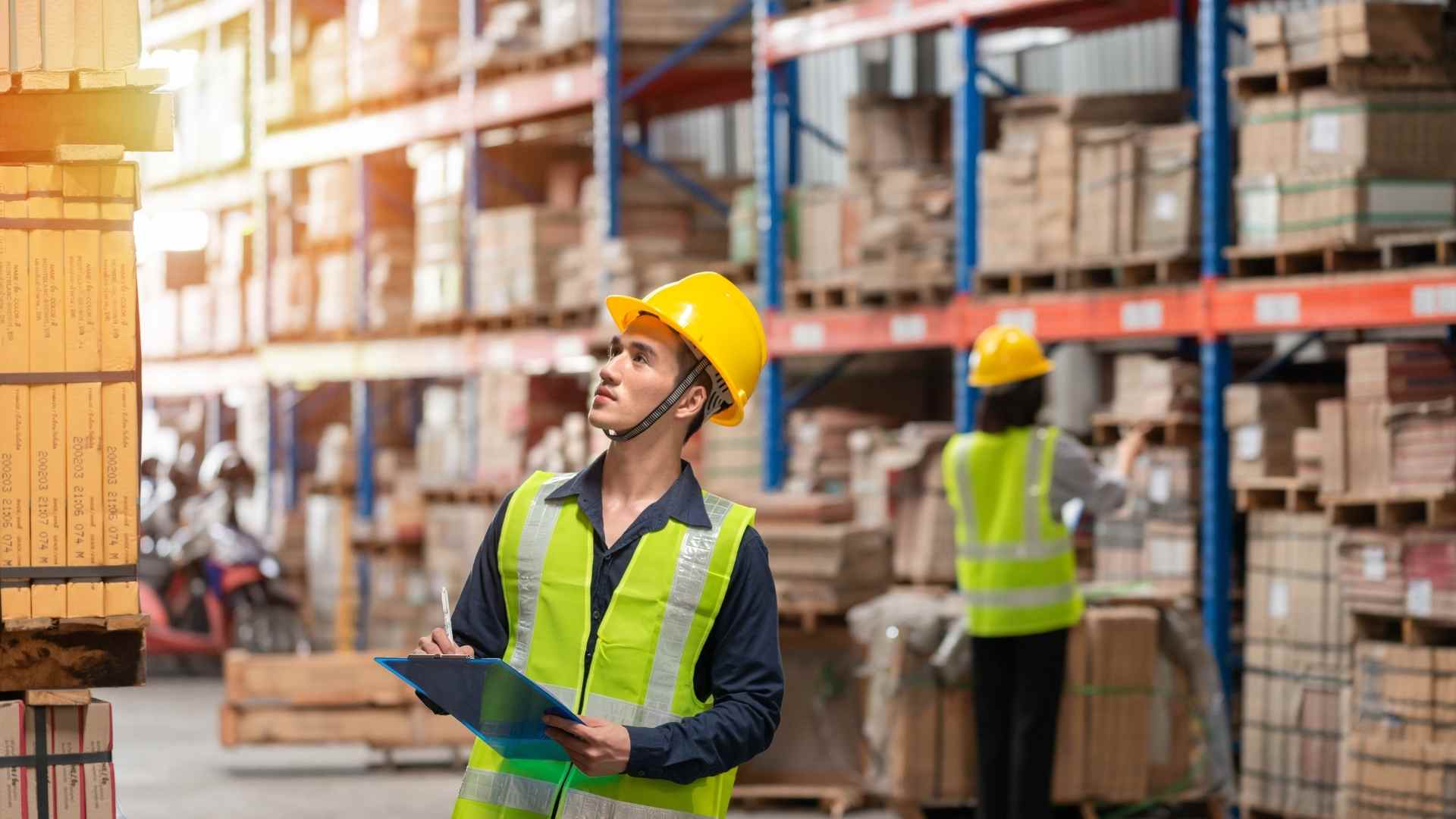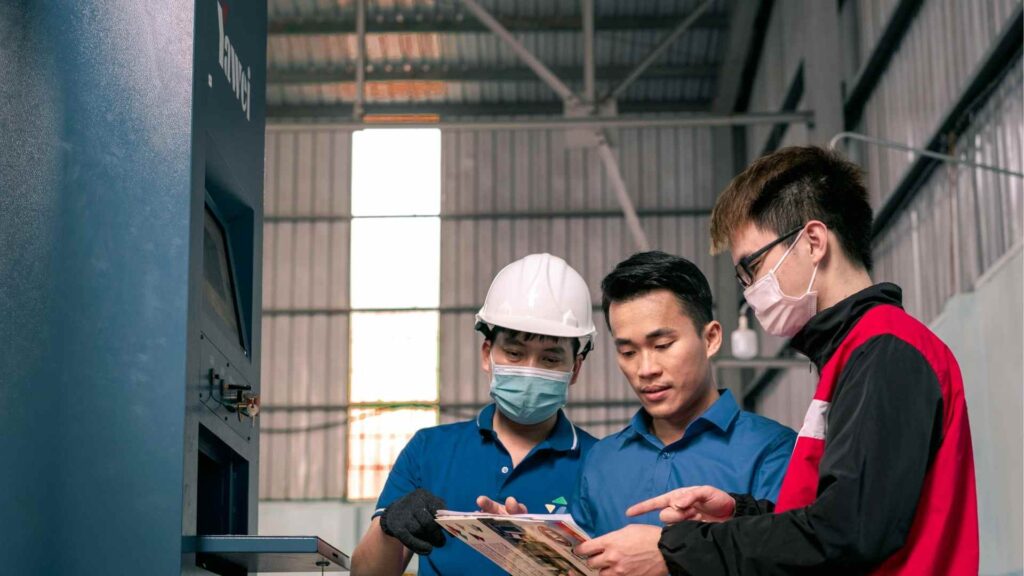Third-party logistics (3PL) providers play a vital role in supply chains, managing storage, fulfillment, and transportation for countless businesses. But behind the scenes of seamless delivery lies a critical factor often overlooked: warehouse safety regulations. Unsafe practices in a 3PL facility can lead to damaged goods, injured workers, and costly disruptions that impact business performance and brand trust.
Here are six reasons warehouse safety should be a top priority when selecting a logistics partner.
Table of Contents
Key Takeaways✔ Warehouse safety regulations help prevent injuries, delays, and inventory loss. ✔ A 3PL’s safety practices reflect its overall operational reliability. ✔ Poor warehouse safety can expose businesses to legal and financial risks. ✔ Strong warehouse rules for employees support retention and performance. ✔ OSHA compliance is a key indicator of a trustworthy 3PL provider. ✔ Clean, organized facilities are essential to warehouse safety and efficiency. ✔ Regular audits and equipment checks show commitment to safety standards. ✔ Evaluating a 3PL’s warehouse safety program protects long-term business goals |

6 Reasons Warehouse Safety Should Be a Deciding Factor When Choosing a 3PL Provider
1. Safe Warehouses Prevent Costly Disruptions
A warehouse with strong safety practices keeps operations running smoothly. Even a minor injury or equipment accident can cause shipment delays, inventory losses, or damage to customer relationships. A 3PL that follows clear warehouse safety regulations helps avoid these risks and ensures greater consistency across the supply chain.
How Safety Standards Reduce Downtime and Keep Operations Stable
- Fewer Accidents Mean Fewer Delays: When employees follow established safety procedures, there are fewer injuries and fewer work stoppages. This allows fulfillment and shipping schedules to stay on track, even during busy seasons.
- Safer Equipment Use Protects Inventory: Proper forklift operation, stacking limits, and designated walkways help prevent dropped pallets, damaged goods, or blocked access to orders. Clear warehouse rules for employees help reduce handling mistakes that could delay customer shipments.
- Emergency Readiness Keeps Shipments Moving: A facility that follows strict warehouse safety regulations is more prepared for fire drills, power outages, or chemical spills. That preparation limits downtime and prevents minor incidents from becoming major disruptions.
2. Strong Safety Cultures Reflect Reliable Partnerships
A logistics partner that invests in safety often brings the same discipline to other parts of its operations. From inventory control to client communication, the presence of structured warehouse safety practices reflects a broader culture of responsibility and consistency. This kind of partner becomes a dependable extension of the business, not just a service vendor.
Why Safety Standards Signal Operational Integrity
- Clear Processes Lead to Fewer Errors: A warehouse that follows strict procedures—like verifying load limits or scanning packages before shelving—reduces mix-ups and shipping mistakes. These processes often grow out of well-enforced warehouse rules and regulations that cover both safety and workflow.
- Trained Teams Build Accountability: When employees are trained not just in lifting techniques but also in handling returns, labeling, and hazardous materials, quality improves across the board. These same team members often enforce warehouse rules for employees that go beyond compliance and focus on doing the job right.
- Routine Inspections Reveal Attention to Detail: Providers who schedule regular safety audits also tend to track KPIs like on-time delivery rates and shrinkage. Their respect for warehouse safety regulations shows in how they manage the finer details of daily operations.
3. Poor Safety Practices Raise Liability Risks
Accidents inside a 3PL warehouse don’t just affect the provider—they can impact the brands that use those services. Legal liability, public relations fallout, and even customer trust are at stake when warehouse safety regulations are ignored. Choosing a safety-conscious partner helps reduce legal exposure and protect long-term business interests.
How Better Safety Reduces Legal and Financial Risk
- Injury Claims Can Ripple Across Supply Chains: A worker injured by unsecured shelving or a pallet jack mishap might file a claim involving multiple parties. Businesses that rely on 3PLs without verified warehouse safety protocols could find themselves named in lawsuits or dragged into investigations.
- Regulatory Fines Can Affect Timelines: If a provider is cited for OSHA violations, operations may be paused, delaying inventory access or outbound shipments. Choosing a partner that clearly follows warehouse rules and regulations reduces the chance of such disruptions.
- Risk Mitigation Attracts Better Insurance Rates: Insurance underwriters consider safety history when assessing liability coverage. Partnering with a 3PL that upholds solid warehouse safety regulations can lower overall risk and help control coverage costs.
4. Employee Morale and Retention Depend on Safety
Workers are more likely to stay with companies that prioritize their well-being. A 3PL with strong warehouse rules for employees not only protects its team but also benefits from lower turnover, higher morale, and stronger productivity. This stability often extends to the consistency and accuracy of logistics services.
How Safety Programs Strengthen the Workforce
- Safe Conditions Attract Skilled Labor: Experienced warehouse workers seek employers who take warehouse safety seriously—who offer clean floors, clear signage, and proper gear. When a 3PL is known for safe practices, it’s easier for them to hire and retain top talent.
- Low Turnover Improves Accuracy: A stable team that understands protocols reduces the risk of errors, from missed scans to improper handling of fragile goods. These outcomes are often linked to well-enforced warehouse rules and regulations.
- Training Boosts Confidence and Efficiency: Employees who are regularly trained on lifting, emergency procedures, and equipment use feel more confident in their roles. This leads to faster picking, safer handling, and fewer costly mistakes tied to rushed or unsafe movement.
5. Clean and Organized Warehouses Are Safer Warehouses
There’s a direct link between cleanliness, organization, and safety. A cluttered warehouse invites accidents, while a well-maintained space supports both protection and efficiency. Many 3PL providers who invest in warehouse safety regulations also follow structured cleaning, labeling, and storage systems that benefit client operations.
Why Order and Cleanliness Are Safety Essentials
- Aisle Clearance Reduces Trip Hazards: Boxes stacked in walkways or loose shrink wrap on the floor can cause avoidable injuries. Strong warehouse rules for employees typically include daily walkthroughs to check for and correct these issues.
- Proper Signage Prevents Confusion: Clear labels for exit routes, fire extinguishers, and hazardous zones help reduce panic and error during emergencies. Following warehouse safety regulations ensures signage is up to date and placed according to code.
- Systematic Storage Minimizes Product Damage: Organized shelving by weight, category, or temperature reduces the risk of improper stacking or storage errors. This kind of precision often stems from adherence to strict warehouse rules and regulations.
6. Safety Audits Help Identify Gaps Before They Become Problems
Ongoing audits help 3PLs catch safety gaps early—before they lead to injuries, damaged goods, or compliance violations. Providers that perform regular evaluations often adapt more quickly to changing guidelines and evolving warehouse environments. This proactive mindset keeps their facilities compliant with warehouse safety regulations and ensures smoother client operations.
How Safety Audits Prevent Costly Surprises
- Routine Checks Reinforce Best Practices: Monthly or quarterly safety walkthroughs help catch blocked exits, loose electrical cords, or faulty racking before they cause harm. These habits are usually written into the provider’s warehouse rules and regulations.
- Audits Keep Training Relevant: Observations from safety reviews often guide future employee training—whether in equipment use, lifting techniques, or hazardous material handling. These adjustments reflect the value placed on consistent warehouse safety.
- Third-Party Reviews Build Trust: When providers bring in outside safety consultants, it signals transparency and commitment to improvement. Clients gain peace of mind knowing their goods are stored in spaces that meet or exceed warehouse safety regulations year-round.
General OSHA Safety Guidelines Every 3PL Should Follow
When evaluating a third-party logistics provider, OSHA compliance is a key indicator of workplace integrity and operational discipline. The Occupational Safety and Health Administration (OSHA) outlines essential practices that help minimize injury risks and maintain consistent productivity. These guidelines often serve as the foundation for internal warehouse safety regulations and shape long-term performance standards in any modern facility.
With the global warehousing market reaching USD 1.01 trillion in 2023, the scale and complexity of operations make strict safety compliance more essential than ever.
1. Ensure Proper Ventilation in the Warehouse
Adequate airflow reduces exposure to harmful fumes, heat stress, and airborne particles. OSHA recommends maintaining good ventilation year-round to support overall warehouse safety and employee health, especially during peak seasonal operations.
2. Implement Lockout/Tag-Out Procedures
Machines and electrical systems must be safely shut down before maintenance or cleaning. Following these procedures protects workers from accidental startups and reflects adherence to federally recognized warehouse safety regulations.
3. Block Off Loading Docks and Fall Hazards
OSHA requires barriers at open loading dock doors and areas where employees could fall more than four feet. A 3PL committed to safety will ensure fall protection is in place—demonstrating proactive warehouse rules and regulations.
4. Keep Aisles and Floors Clear of Hazards
Slips, trips, and falls are among the most common warehouse injuries. Clean, well-marked walkways and dry surfaces are signs of daily enforcement of clear warehouse rules for employees.
5. Train Employees for Extreme Temperatures
Warehouses without proper insulation or temperature control can expose workers to heat stroke or hypothermia. OSHA recommends training staff to identify early signs of temperature-related stress and ensuring climate protocols are part of routine warehouse safety practices.
6. Teach Ergonomics for General and Specific Tasks
Proper lifting techniques, posture guidance, and workstation design reduce injuries like strains or repetitive motion disorders. These practices, when included in a 3PL’s warehouse rules for employees, help maintain productivity and lower downtime.
7. Provide Periodic Rest Breaks for Physical Tasks
Overexertion can lead to fatigue-related injuries and decreased focus. OSHA advises regular rest periods, especially for tasks involving heavy lifting or repetitive motion, which should be built into all warehouse safety regulations.
8. Consider Task Safety When Planning Workflows
Employers are encouraged to account for safety when setting task timelines—not just speed or quotas. A safety-conscious 3PL will balance efficiency with responsible planning, reflecting strong warehouse rules and regulations across its operations.
How to Evaluate a 3PL’s Warehouse Safety Program Before Signing a Contract
Before entering a logistics partnership, it’s critical to examine how seriously a third-party provider treats warehouse safety. A polished website or sales pitch doesn’t always reflect day-to-day conditions in the facility.
With global retail e-commerce sales expected to surpass $4.3 trillion, the pressure on 3PLs to move faster is higher than ever. To avoid costly mistakes, decision-makers should ask the right questions, request specific documentation, and look for visible signs of well-enforced safety practices.
1. Request the Provider’s OSHA Safety Records
A reputable 3PL should have no problem sharing its OSHA injury logs or most recent inspection results. These records reveal patterns in workplace safety and help verify whether the provider is actually compliant with required warehouse safety regulations. If the provider hesitates or offers vague answers, it’s a red flag worth investigating further.
2. Ask About Employee Safety Training Programs
Training should go beyond basic onboarding—it should include routine refreshers on ergonomics, forklift operation, hazardous materials, and emergency drills. Professionals who prioritize warehouse rules for employees typically offer structured training at least quarterly, with documentation to back it up. Ask to see a sample training schedule or curriculum to gauge how seriously safety is prioritized.
3. Observe the Facility During a Site Visit
During a walk-through, look for blocked exits, frayed cords, cluttered aisles, or expired safety signage. These issues often indicate poor enforcement of warehouse rules and regulations and signal a lack of internal accountability. A clean, organized facility with clear markings, protective barriers, and visible PPE use is a strong sign of a professional operation.
4. Review the Safety Audit Frequency and Process
Professionals conduct internal safety audits regularly—often monthly or quarterly—and use those findings to improve operations. Ask how audits are performed, whether third-party consultants are involved, and how often corrective actions are documented. A 3PL that takes warehouse safety seriously will treat audits as routine maintenance, not reactive damage control.
5. Evaluate Their Equipment Maintenance Protocols
Broken pallet jacks, damaged racking, or leaking forklifts are not just operational issues—they’re major safety risks. A reliable provider should maintain detailed logs for inspections, repairs, and preventive maintenance to meet warehouse safety regulations. Well-maintained equipment shows a level of professionalism and care that directly affects worker safety and product handling.
6. Confirm That Safety is Embedded in Daily Operations
Ask how safety fits into the provider’s daily meetings, performance reviews, and workflow design. Some 3PLs include safety goals in team metrics, reinforce rules during shift huddles, or reward employees for spotting hazards. This kind of culture proves that warehouse rules and regulations aren’t just written down—they’re lived out on the floor.

Frequently Asked Questions
Are warehouse safety regulations different for cold storage facilities?
Yes, cold storage warehouses must follow general OSHA guidelines while also meeting temperature-specific safety requirements. This includes protecting workers from prolonged exposure to extreme cold, providing insulated gear, and ensuring equipment functions properly in sub-zero conditions. Specialized warehouse rules and regulations may also require shorter shift durations and mandatory warm-up breaks. These added layers help maintain compliance and reinforce overall warehouse safety in temperature-controlled environments.
Can a business be held liable if a 3PL violates safety laws?
While the 3PL is primarily responsible for safety within its facility, businesses that fail to vet their logistics partners may still face legal and reputational consequences. If a brand knowingly works with a provider that neglects warehouse safety regulations, it could be exposed during lawsuits or audits. In certain cases, joint liability claims can arise, especially if incidents affect shared assets or branded goods. Choosing a 3PL that enforces strong warehouse rules and regulations helps reduce that risk significantly.
How do warehouse safety rules apply during peak seasons?
During high-volume periods like holidays or product launches, safety risks often increase due to higher traffic, new temporary workers, and tighter deadlines. A professional 3PL should reinforce warehouse rules for employees, not relax them, during these times. This includes doubling down on equipment checks, enforcing break schedules, and monitoring fatigue. Following consistent warehouse safety regulations under pressure is a sign of a dependable partner.
Are digital tools used to enforce warehouse safety?
Yes, many modern warehouses use digital platforms and sensors to monitor employee movement, equipment usage, and environmental conditions. These tools help enforce warehouse safety regulations in real time, flagging issues like unsafe forklift speeds or blocked emergency exits. Some systems even integrate safety alerts directly into employee handheld scanners. Leveraging technology supports smarter warehouse safety while reducing manual oversight demands.
What role does signage play in warehouse safety?
Clear signage is a critical part of any effective safety program, guiding both employees and visitors through potentially hazardous areas. OSHA requires signs for emergency exits, restricted zones, chemical storage, and PPE reminders. Proper signage supports compliance with warehouse safety regulations and helps enforce daily warehouse rules for employees. A warehouse lacking visible, up-to-date signage may not be prioritizing safety as it should.

Partner with 3PL Warehouse By Best for Safe, Reliable Logistics
At 3PL Warehouse By Best, safety isn’t a checklist—it’s the foundation of how every shipment is stored, handled, and delivered. Our New York, NY, facility is built around strict warehouse safety regulations, clean workflows, and fully trained staff who know how to move with purpose and precision. Whether managing seasonal spikes or complex product lines, we keep operations running smoothly with warehouse rules and regulations that protect both your inventory and your brand.
Let’s move smarter, safer, and more efficiently—together. Contact us today!

